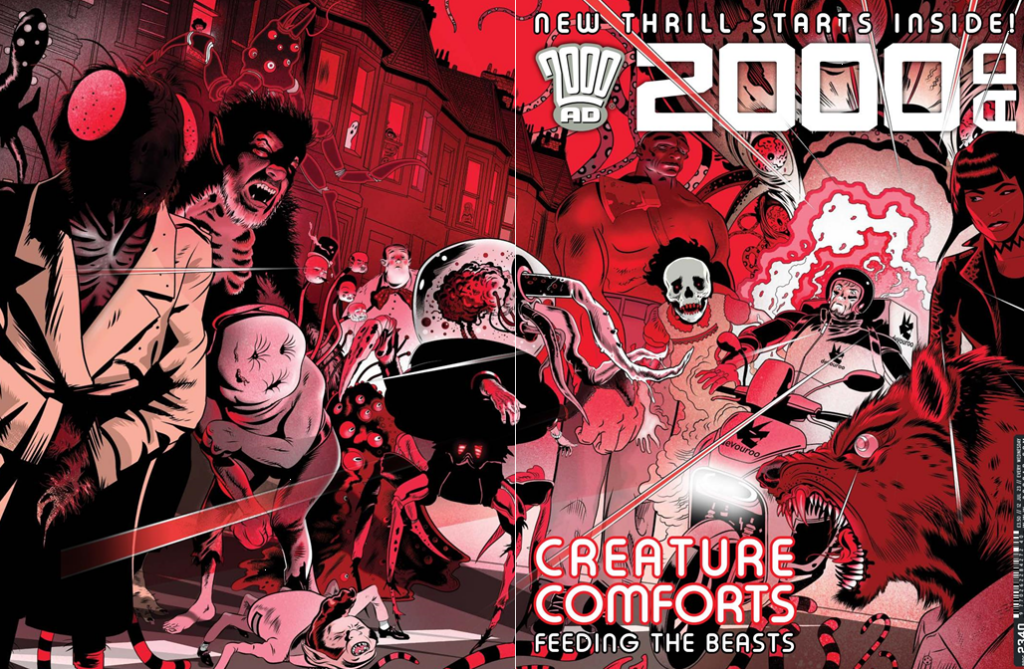‘Monster Appetite? We Deliver… You Devour.’ Talking Portals & Black Goo with John Tomlinson
16th July 2023
Out now in 2000 AD Prog 2340, brand-new horror-comedy Portals & Black Goo follows the travails of Devouroo delivery drone Kroy Plemons as he serves the creatures of the night that live amongst regular Londoners.
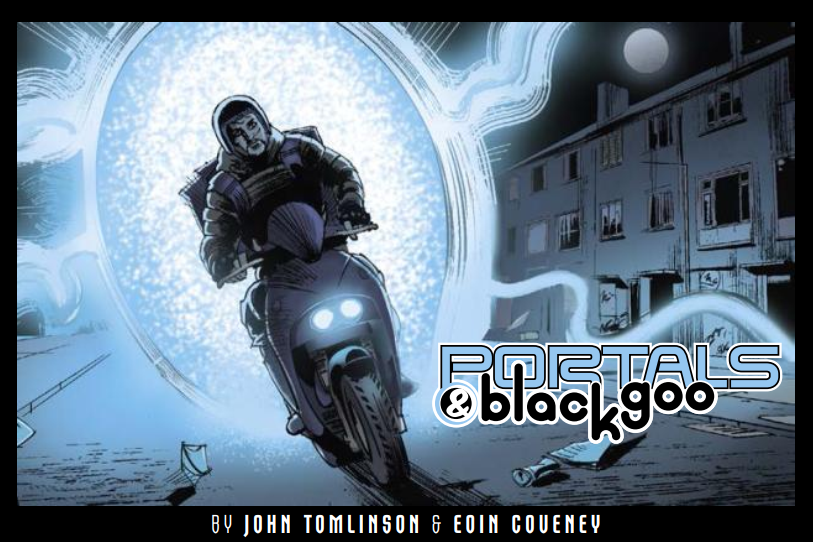
Created by John Tomlinson and Eoin Coveney, this one’s a satirical look at modern working, the plight of zero-hours contract work, the never-ending drive for everything to be faster, and the prejudice faced by any and all marginalised groups in our society. But it does it through a lens of a world where the old monsters are living amongst us.
And when we have vampires, demons, werewolves, and all manner of old evils living alongside Londoners, just what the hell are they meant to do for food – seeing as the native population is off the menu.
Well, the answer is Devouroo – ‘We Deliver… You Devour.’ Whether it’s bags of fresh plasma for vampires, bloody bones for djinn, or steaming viscera for werewolves, the put-upon scooter riders of Devouroo will bring it to you. But of course, in a cutthroat world of food delivery where the customers are hungry for blood, it’s always going to be a nightmare getting the job done.
John, or Automatom-Linson as he was known around these parts, is an integral part of the history of 2000 AD, not only as a writer and creator (of Armoured Gideon, Mercy Heights, and Tor Cyan) but also serving as Tharg’s Earthly representative as editorial assistant droid (Progs 828-914) and editor (Progs 915-977) of 2000 AD, editor of Judge Dredd: Lawman of the Future (issues 13-23) and editor of the Judge Dredd Megazine (issues 3.13-3.21). At some point, we’ll pin him down to talk in more depth about those illustrious positions, but right here, right now, it’s all about Portals & Black Goo!
We’ve already talked to Eoin Coveney about it and seen of the fabulous artwork, but now it’s time to chat to John Tomlinson about Portals & Black Goo!
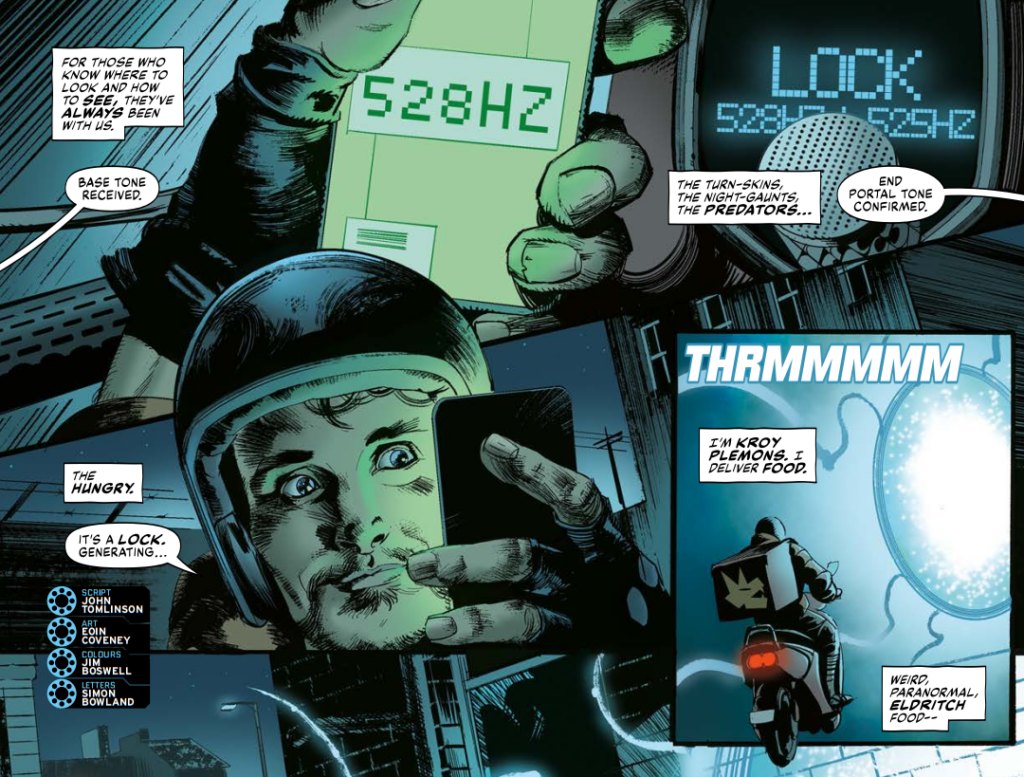
From Portals & Black Goo: Night Shift part 1, 2000 AD Prog 2340, art by Eoin Coveney
Hello John, the new series Portals & Black Goo begins this week in 2000 AD Prog 2340, a brand-new seven-parter looking at a world where the monsters live amongst us. But it’s not your normal horror tale at all. Instead, you’ve taken a sideways look at what this world might be like, wondering just what it is that these traditional monsters do for food.
Tharg’s already described it as ‘combining comedy-horror with social satire of the zero-contract culture and the prejudice a section of the populace can face.’
So, John, what’s Portals & Black Goo all about?
JOHN TOMLINSON: On the surface, it’s about a food delivery service for monsters. These creatures of legend have been with us since the dawn of time (or at least the dawn of storytelling), but are still frequently depicted as lurking in the shadows, loitering around ancient buildings or on blasted heaths. If they hoped to survive, they’d surely have to move with the times like everyone else.
In Portals & Black Goo (hereafter P&BG), werewolves still feast on steaming viscera, but now they’re just as likely to order via an app as to prowl the hills or the nearest zoo.
Most of the monsters in P&BG live in Battle Hill, a crumbling sink estate where cash-strapped and/or terrified local authorities marooned them decades earlier. It’s a grim and lawless locale, a no-go zone where few humans dare to venture – except for Devouroo riders.
Without crashing headlong into a subtext, Brexit and all that followed with it have unearthed an unpleasant seam of bigotry in the British psyche. Not long ago there was a spate of viral YouTube videos of white people (often middle-aged women, for some weird reason) going absolutely bat-shit on public transport at some hapless fellow passenger, invariably of a different ethnicity. In P&BG the monsters are the focus of this spittle-flecked fury, and I’ve just tried to show the sheer ugliness of it all. Why all the bile? Was it always lying dormant, awaiting the rise of the Right? ‘Why can’t we all just get along’?
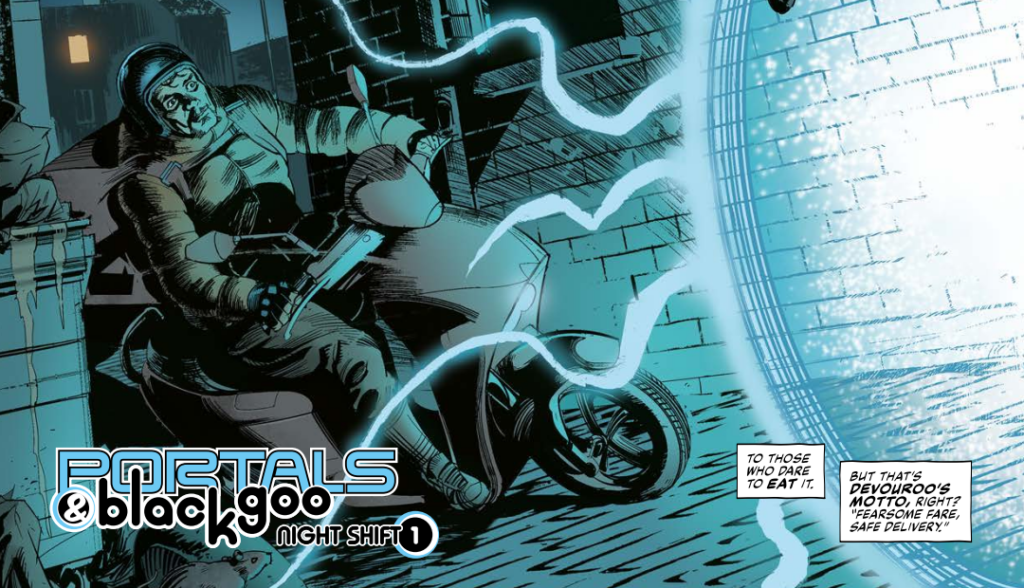
From Portals & Black Goo: Night Shift part 1, 2000 AD Prog 2340, art by Eoin Coveney
John, how did it all come about – according to what you said here it’s something that came to you one night – ‘a confused Deliveroo rider stopped me for directions after his phone conked out. Walking home after, it struck me that they must have to deliver to some pretty scary places and people.’
After that you came up with the line ‘Hungry Horrors: food delivery for children of the night. Charnel@£1.99!’ And that’s as good an elevator pitch as any I’ve heard, completely summarising the concept perfectly.
But of course, there’s a lot of work in between elevator pitch popping into your head one night and finally seeing the strip in the Prog! What sort of development did Portals & Black Goo go through to get it to the finished product?
JT: When writing for 2000 AD, Terror Tales come more naturally to me than Future Shocks, and P&BG was no exception. 2000 AD does sprawling galactic epics exceptionally well, but it doesn’t need another one from me – I wanted to combine SF and horror in a familiar urban setting.
As I said, it all began to coalesce (or congeal!) when a Deliveroo rider stopped me for directions. I’m a pretty slow and methodical writer, and sometimes plotting can be a slog. Every so often though, I get an idea from which a bunch of others cascade, and I know I’m onto something.
The initial outline I sent to Matt Smith was all about Kroy Plemons’ perilous quest to deliver dinner to a terrifying supernatural entity. But it was soon clear that this wouldn’t be enough to sustain the whole series, so I began to flesh out the supporting cast and their various backstories. Matt also asked me to develop the feud between Kroy and his arch nemesis, Dwayne Shedd of rival delivery service DaHunga. For anyone who remembers Ace Trucking Co., there’s more than a hint of Ace and Kain about their relationship.
Another big influence was Cursitor Doom, the old IPC wizard who was my favourite character in SMASH! as a kid. Years later I got to write a Doom story for a 2000 AD Action Special, drawn by Jim Baikie, where the brief was to reinvent and/or subvert legacy IPC characters for the 90s. But when it came to the crunch I found I didn’t want to graffiti all over my childhood hero, and so I ended up writing a very recognisable Doom.
You can find the whole of John’s Cursitor Doom: The Man Who Died Every Day strip right here at Back From The Depths. Here’s a couple of those beautiful Jim Baikie pages…
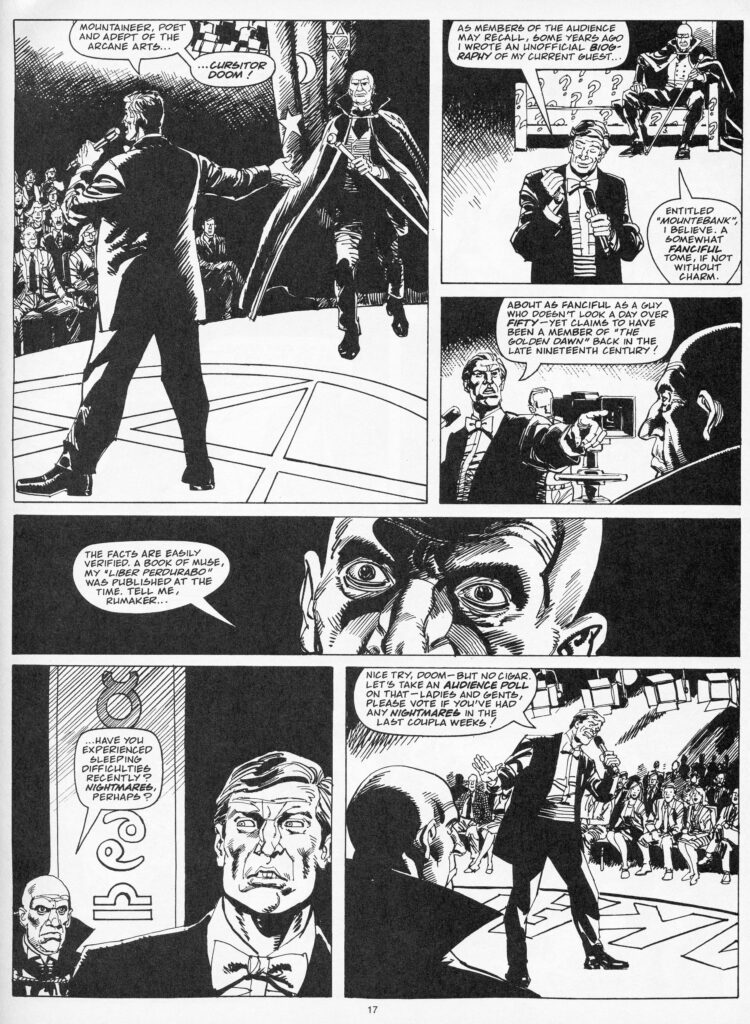
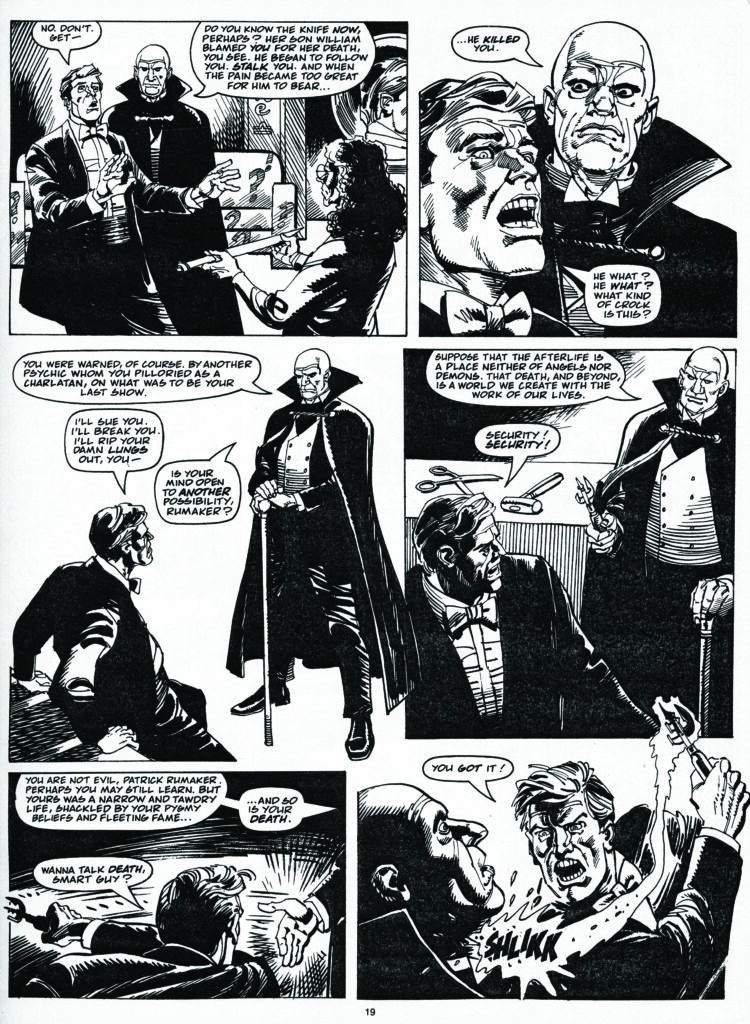
>
JT: The wizard in P&BG isn’t Doom, but is perhaps what the Action Special version could have been, had I followed the brief.
A once powerful sorcerer, he lives in a squalid Council flat, wears baggy sports gear and has a gammy leg. Possibly centuries old, he claims to live on air but is surrounded by Pot Noodle empties. He’s still a powerful wizard, but is hopelessly out of touch with the modern age, plagued by ill health and nurses a grudge against his richer, smoother, more famous brother.
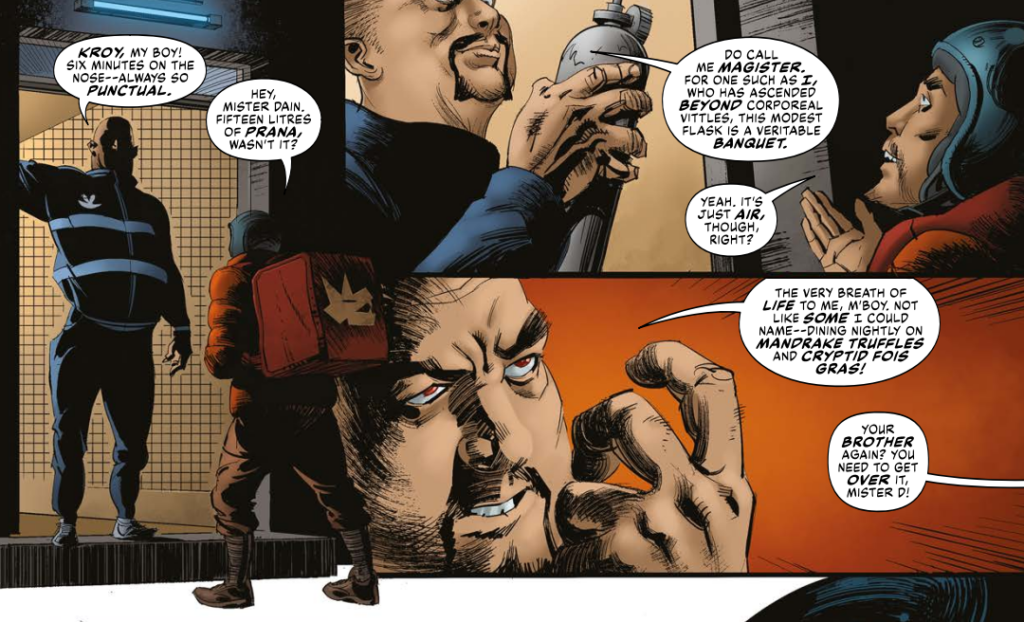
From Portals & Black Goo: Night Shift part 1, 2000 AD Prog 2340, art by Eoin Coveney
Obviously, we’re not just going to be having seven episodes of a Devouroo driver making deliveries – although to be honest, that would actually work, a new weird setup for a delivery every episode.
JT: I’d actually like to do that too… there was no room for it this series, but I had a fun idea for a scenario in which Kroy gets trapped in a ‘Dark Store’ – one of the eerie collection points from which Devouroo riders pick up their food orders. And it’s more hideous and terrifying than he ever imagined. At this point though I’ve no idea how the series will be received, so whether or not I get to write more is (as ever), a matter for Tharg and the readers.
We’re introduced to the world of Portals & Black Goo in the two episodes I’ve seen through the life of poor old Kroy Plemons, Devouroo delivery bloke, delivering all sorts of food to the monsters of this world through a series of ‘eldritch resonances that generate temporary portals large enough for a bike’.
JT: This was inspired by YouTube videos of a guy who claimed to have opened a portal to Sedona in his bedroom, by generating resonant harmonics on a Bluetooth speaker. He hadn’t – if only! But it was ingeniously done, both SPFX-wise and in his laid back, convincing approach and it stayed with me.
Kroy has to deal with all the usual crap delivery drivers have to put up with, but with an added element of danger thanks to just who he’s delivering to and who he’s working for.
And it’s from this that you’ve crafted the seven-part series. What sort of nightmares are going to be bothering Kroy in the rest of the series?
JT: The catalyst for this series is Kroy’s relegation to Devouroo’s ‘Night Shift’, from which few riders return. Whilst running this potentially lethal gauntlet he gets stranded between dimensions, a predicament for which the only escape is to complete the delivery – and for reasons of spoilerage I won’t reveal, that’s no longer possible.
It’s a test of his wits and courage and he still might die. In the meantime his friends are all in danger and he can’t save them. He has to play the ‘elevator game’ too, for which you’ll also find much intriguing spooky nonsense on YouTube. Some of the videos are so well produced – almost Paranormal Activity quality creepiness – that I’m actually too freaked out to try it myself.
Oh yes, the Elevator Game – you can find more out about that at YouTube, but it was also in an episode of the rather overlooked and rather bloody good US series Evil – S2, Episode 4, E is for Elevator, with a good summary here at Vulture.
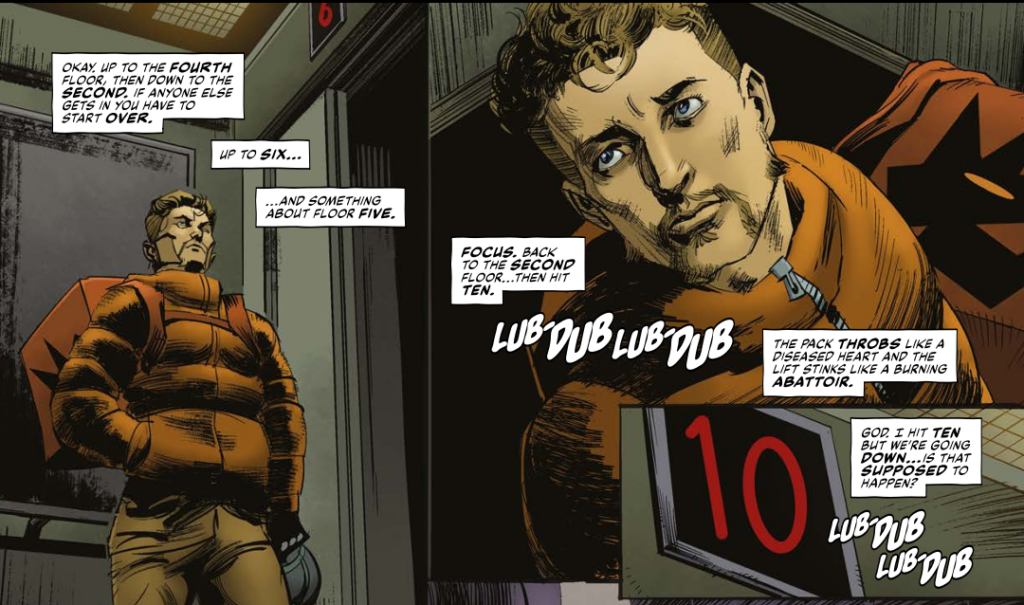
From Portals & Black Goo: Night Shift part 2, 2000 AD Prog 2341, art by Eoin Coveney
John, you’ve taken a great fantasy idea and rooted it firmly in the now, the sort of thing 2000 AD has always done through its history. It’s sci-fi horror with a twist of comedy through it.
JT: Thanks – although I’m always a bit wary of a series that’s billed up front as a comedy, because 2000 AD readers are famously resistant.
There has always been a rich seam of black humour in 2000 AD (stemming from the strange and twisted wit of Mills, Wagner, Grant et al), but it seems to work best as a side dish rather than the main. If you read P&BG expecting a laff riot you may be disappointed, because it’s more about the story and characters. There’s some nasty humour too though.
And the cast of characters, even just two episodes in, are all so wonderfully diverse and interesting, whether it’s creatures of the night or the poor bastards out on their night shifts.
Of course, a lot of that characterisation and style comes from Eoin Coveney interpreting your script. You’ve already been fulsome in your praise of Eoin’s artwork when the series was announced here at 2000 AD.com, saying this… ‘I’ve always thought that the best comics artists are also actors, and Eoin has really brought the characters to life. Enhanced by Jim Boswell’s suitably creepy colours he’s done an amazing job – the characters and settings are very ‘real’, thus making the fantastical elements more convincing. I couldn’t be happier with the finished result.’
JT: I should add that I first saw Eoin’s art when he drew the title page of one of my Terror Tales [Wunza, Prog 2285], the original artist having become unavailable after turning in the rest. It was by far the best page of the six: clear storytelling and composition; consummate drawing skills and a real knack for body language and facial expressions. The characters really seemed to live and breathe.
I suggested him to Matt Smith for P&BG – luckily he agreed and Eoin was available. Colourist Jim Boswell was another inspired choice but I wasn’t involved in that one. Not forgetting Simon Bowland, one of Comics’ busiest and best letterers.
And yes, the finished product looks excellent – Eoin and Jim have definitely got a darkness to the whole thing that works really well, and we all know how good Simon’s work is.
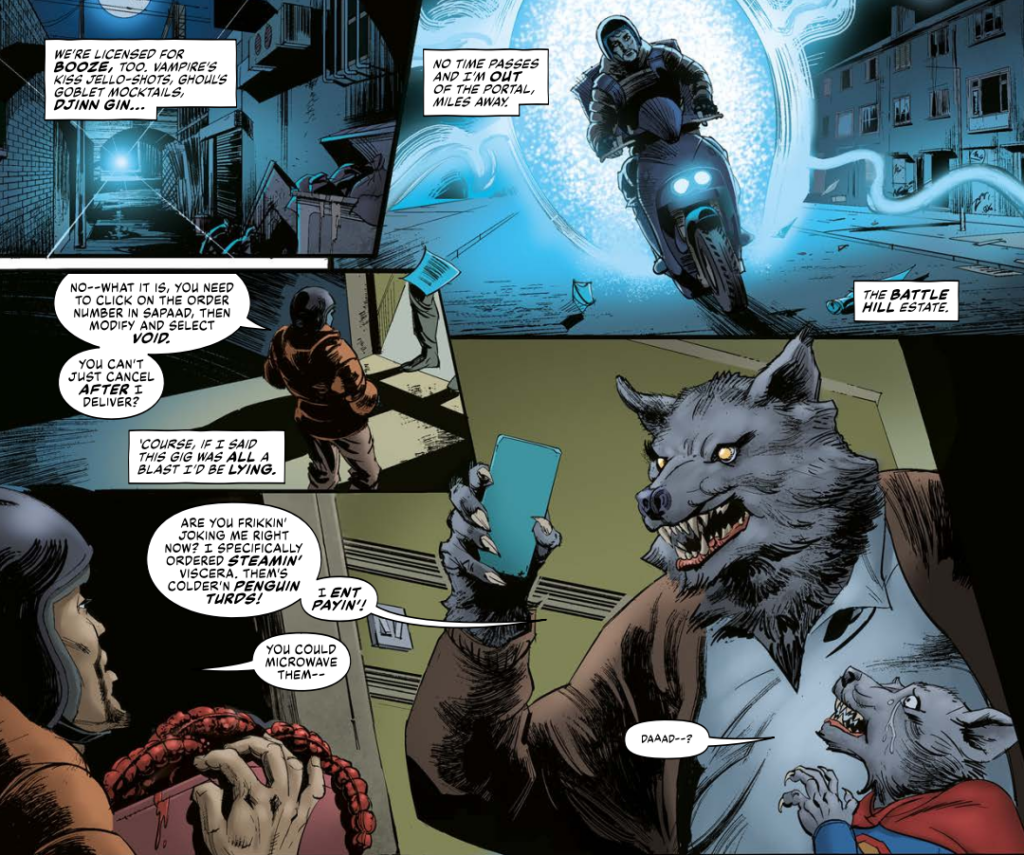
From Portals & Black Goo: Night Shift part 1, 2000 AD Prog 2340, art by Eoin Coveney
Now, as we’ve not interviewed you before, let’s get a bit of background from you.
John, you’ve been making comics since the very end of the 80s – what’s your background and why did you get into comics writing?
JT: I started at Marvel UK fresh from Art College, a B.A. course in Graphic Design. But I’d always loved comics and, in the second year of the three-year course was a placement scheme whereby students could do two weeks work experience at a Design or Ad agency. For me, this was my big break and I ended up at Marvel. I was put to work editing and laying out the Spider-Man letters page, answering readers’ letters in cod Stan Lee-speak. I also drew small pieces of artwork for feature pages and free gifts. The two weeks turned into a month (they were busy) and after getting my degree I contacted Marvel again offering my services. I was on staff within weeks.
I’d always wanted to get into Comics – initially as an artist. That ambition lasted until my work experience stint at Marvel UK, where I saw Steve Dillon’s gorgeous brushwork for Abslom Daak, Dalek Killer. Still a teenager at the time, he was already drawing like a seasoned pro and my scratchy Rotring pen etchings couldn’t compare. As Clint said, ‘a man’s got to know his limitations.’ I’d always written stories for fun, but it wasn’t until Captain Britain, Zoids etc. that the penny dropped and I started writing for actual Creds.
The first thing I wrote was a text story for Captain Britain monthly, since (editor) Ian Rimmer didn’t have the budget to commission a professional writer. Later, after seeing how much fun Simon Furman was having writing Transformers, I wrote a few stories for another toy tie-in title, Zoids. Various Thundercats and Doctor Who stories followed, all under the pseudonym Steve Alan. At the time I claimed that this was because everyone of any note in Comics at the time seemed to be called either Steve or Alan. The terrible truth was, I still lacked confidence and wasn’t ready to go out in public under my own name. I couldn’t even type – I wrote everything longhand and bribed Marvel’s receptionist Wendy to type the scripts for me, a process that worked beautifully (Wendy certainly didn’t mind) until Managing Editor Jenny O’Connor got wind and decreed that I learn to type myself. Bleedin’ outrage! I’m grateful now of course.
The first thing I wrote as me was a Future Shock, Fat Chance, (Prog 609, 1989) drawn by Simon Jacob. Richard Burton and Alan McKenzie (joint-Thargs at the time) liked it and tasked me with devising a series for Simon. The result was Armoured Gideon, a story about a dimension-hopping, demon-slaying robot. Enraged villagers with flaming torches failed to appear so I’ve been writing as me ever since.
Am I right in thinking you were away from comics for quite some time before coming back into 2000 AD relatively recently?
JT: But for a few Judge Dredd stories, there were fifteen years between my last 2000 AD series, Tor Cyan [the last episode of which was in Prog 1299, 2002] and my recent stuff. I spent most of that time at the part-work Publisher Eaglemoss, editing Lords of the Rings part-works and Comics-related titles like Marvel Fact Files. That was great fun and I got to commission some of my personal heroes, including a Doctor Strange cover from Dave Gibbons and some Captain Britain features written and illustrated by Alan Davis. My favourite was one in which Alan revisited his cover of Captain Britain monthly #1 for a Marvel UK-themed issue. But I’d always wanted to get back to actually writing comics, rather than just writing about them.
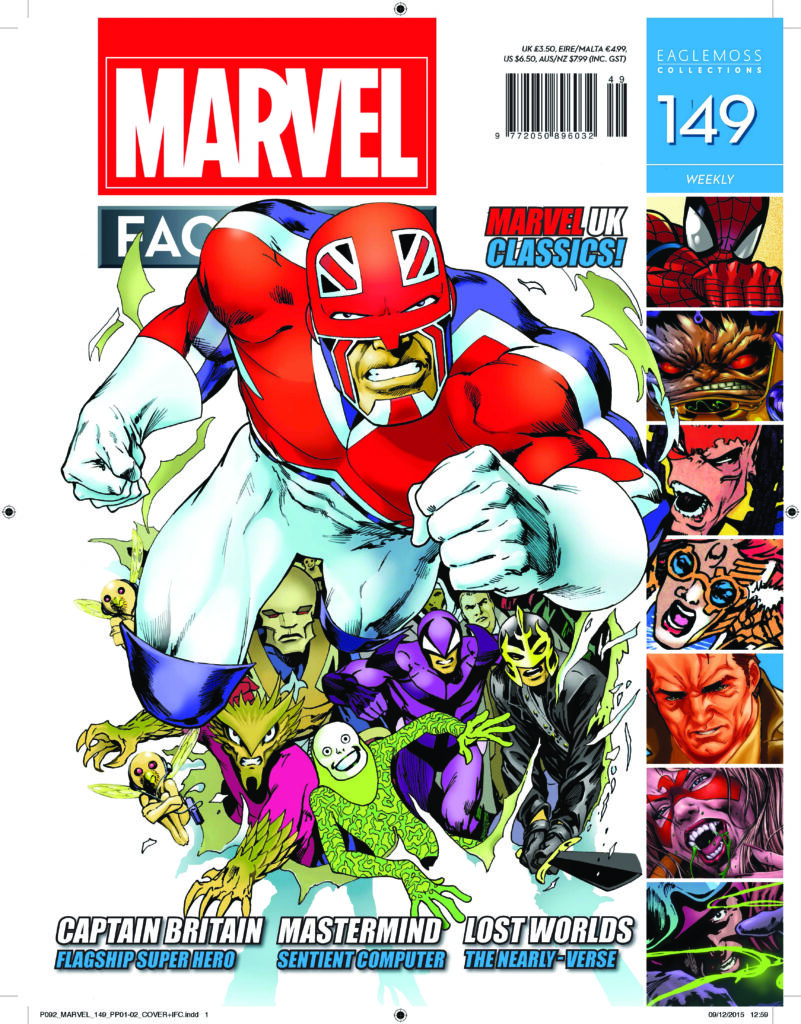
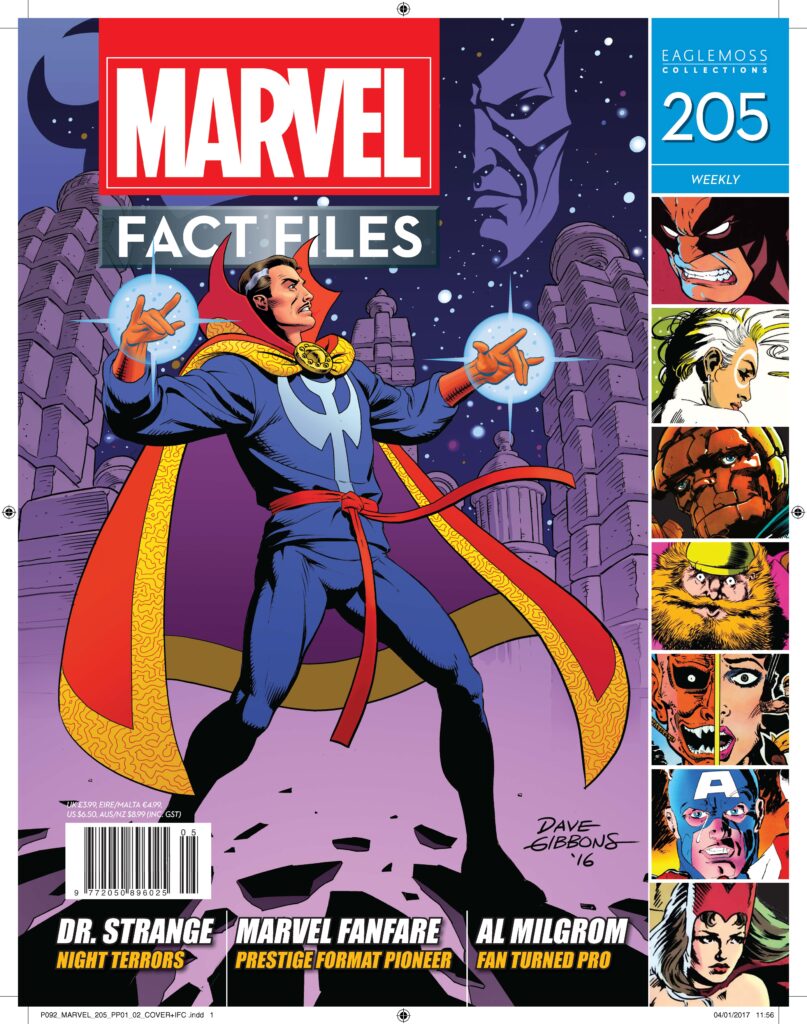
Alan Davies revisiting his cover to Captain Britain Monthly & a Dave Gibbons Doctor Strange cover.
>
When I quit Eaglemoss I approached Matt Smith about the possibility of writing more Dredd. But things change in fifteen years, and Tharg now has a healthy roster of talented Dredd Script Droids. What he didn’t have enough of was Future Shocks or Terror Tales. Stephen King once defined the process of short story writing as ‘five-finger exercises’, and for me it’s the same with one-off strips for 2000 AD. To set up a premise, get a cast of characters on and offstage and end with an (ideally) unexpected twist, all in five or six pages, is harder than it looks. I think every comics writer should be made to do it occasionally (you know, like an M.O.T.), and I’ve had such a blast writing Terror Tales in particular. It’s great to be writing a full series again though.
What is it about 2000 AD that keeps dragging you back?
JT: When I started reading comics as a kid there was a full shelf of them in every Newsagent, every week. 2000 AD is the sole survivor, and it’s endured because it was the best and most original. For a writer (and I can’t emphasise this enough) there’s nothing like it, anywhere in comics.
Where else can you conceive a whole universe of original characters, developed, written, and realised pretty much as you envisioned them, and see the whole thing in print within months, if not weeks? I’ll tell you – nowhere! 2000 AD is unique in that regard. We’ll miss it when it goes – but of course, I hope it never does.
When I was Tharg, the readers’ most commonly asked question was ‘what will 2000 AD be called in the year 2000?’ The future has long since become the past but the Galaxy’s Greatest Comic endures, as quirky, innovative and brilliant as ever.
And on 2000 AD and comics in general, when did you first get into comics as a reader? What comics were you reading as children, teens, and when was it that you first noticed 2000 AD?
JT: The first comic I remember reading as a kid was SMASH!, to which I remained obstinately committed despite my parents’ attempts to move me onto the likes of Look and Learn. The standout strip for me was Cursitor Doom, with its beautifully eerie Eric Bradbury artwork. Later came The Mighty World of Marvel, Spider-Man Comics Weekly, Dracula Lives, and other reprint titles. Some idols loom like Mount Rushmore in your personal pantheon, and I now can’t imagine my childhood without Lee, Kirby, Ditko et al.
I continued to read British comics too, and was totally captivated by Action. In an era when the BBC were being castigated for some pretty tame violence in Starsky & Hutch, Action had divers being eaten alive by baby sharks in Hookjaw, and Dredger gleefully running over heads with artic lorries. The same creative and editorial team gave us people being scoffed whole by giant salivating dinosaurs in 2000 AD, which I read avidly for the first 100+ issues. Why I stopped, I’ve no idea – but when I joined Marvel UK, Simon Furman and Richard Starkings were big fans so I’d read their copies.

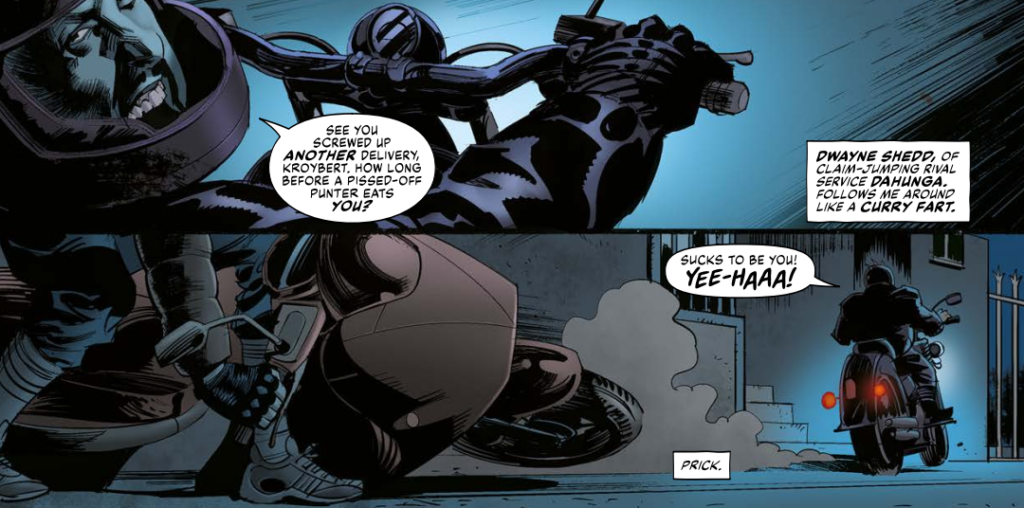
From Portals & Black Goo: Night Shift part 1, 2000 AD Prog 2340, art by Eoin Coveney
Going to the interviewer’s book of 101 obvious questions… what/who are particular influences on your work?
JT: I grew up with the stories of Stephen King and Richard Matheson, writers who brought horror fiction into the modern world. For about three years I read nothing but Harlan Ellison, so inevitably he’s seeped in. Comics-wise, the biggest influences are still Stan Lee, Jack Kirby and Alan Moore. Al Ewing continues to confound and inspire too, not just with his twisted imagination and use of language but also his sheer output – he’s obviously cloned himself. And writing with Dan Abnett and Steve White on The Knights of Pendragon and The Lords of Misrule was undoubtedly a big influence – we had such a laugh on those and I’m still proud that I got Dan into 2000 AD (and commissioned Sinister Dexter) during my stint as Tharg.
And finally, before we end, given carte blanche at 2000 AD, what strip/story idea would you love to get into the pages of the Prog? Maybe a reboot of something old, maybe a bizarre team-up you thought of one day in the bath, maybe something completely different.
JT: I had a grand notion for a Judge Dredd Megazine epic, Shield of Winter, in which a Rookie female Judge has to bring in a veteran Long Walk Judge who’s blasted his way back into the Big Meg on a revenge mission. It was a kind of True Grit scenario – I could ‘see’ it so clearly, was itching to write it, and I’m still crushed that Tharg didn’t go for it! So there’s that.
But rejection is the risk every writer faces, and you can’t let it discourage you – as Judge Winter himself says at one point (or would have!), nothing worthwhile comes easy.
I’ve since read the autobiography of Dick Clement and Ian La Frenais, who wrote all the best TV sitcoms when I was a kid. For every Porridge, Likely Lads or Auf Wiedersehen, Pet there were shelves of unproduced sitcoms and screenplays, but it didn’t put them off. I highly recommend Otley and Villain btw, two of their early movies. You won’t regret it.
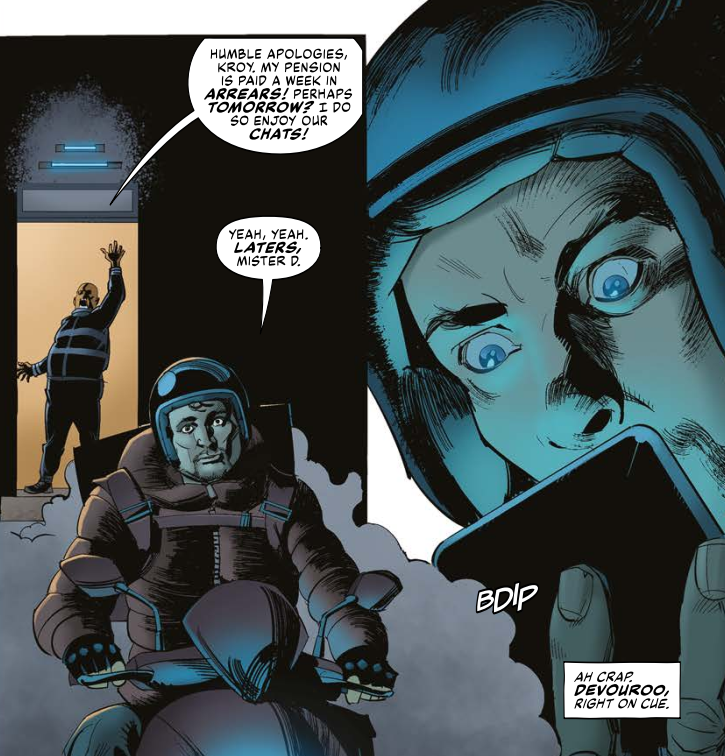
From Portals & Black Goo: Night Shift part 1, 2000 AD Prog 2340, art by Eoin Coveney
Now, to end these we always like to end with a chance for you to tell us what you’re working on and what we can expect to see from you in the near (and maybe not so near) future?
First of all, are there plans for more Portals & Black Goo?
JT: I have plenty of ideas for a second, even a third series of P&BG. Whether or not it happens depends on how well the first lands with readers, and if Matt thinks the concept still has legs after Night Shift. Needless to say I’d love to write more, and if so I hope Eoin will be available to draw it.
And what’s lined up from your good self for the rest of 2023 and into 2024? More for 2000 AD? Elsewhere?
JT: I’ve been working on a horror limited series idea that’s probably about ready to start submitting to Editors. In my spare time I’m also co-writing a SF detective novel with a comics writer mate.
As a kind of experiment, I wrote a pilot episode for an audiobook sitcom and hired a superb actor to record it – I saved money by producing the music and FX myself and it sounds surprisingly professional! Where it’ll lead, who knows…
Otherwise, I’m keeping the wolf from the door with freelance editorial jobs, ministering to my incredibly busy wife, walking the dog, and forcing myself to go to the gym. I also had time to design a few Devouroo ads for a P&BG teaser campaign on LinkedIn, presented here for your consideration. If you find yourself salivating though, you’re in big trouble…
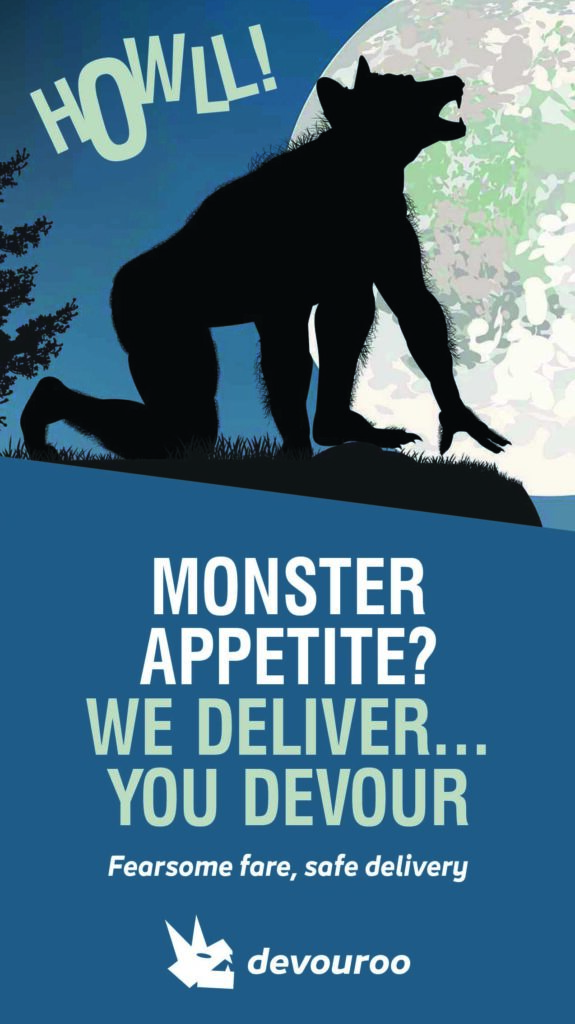
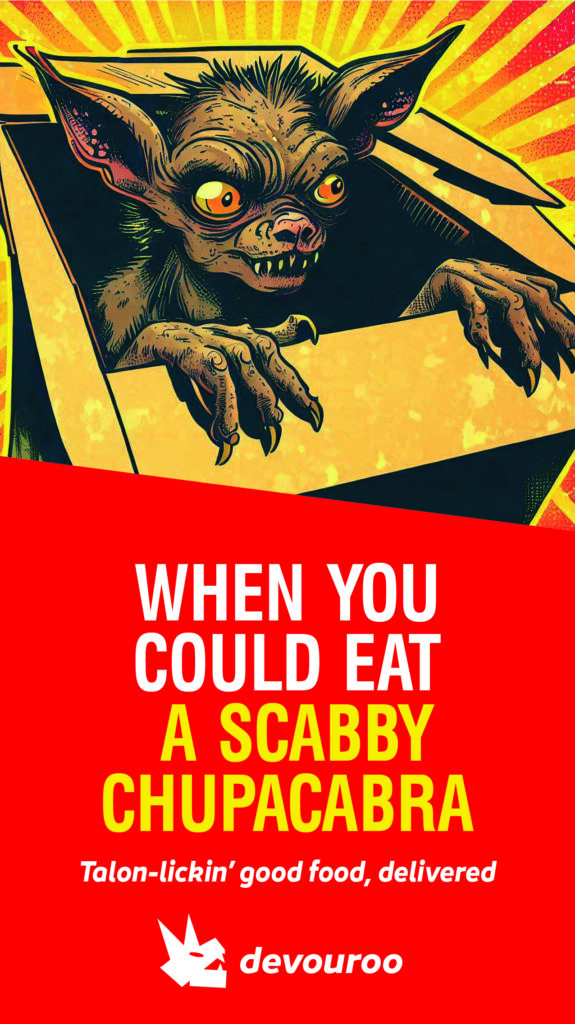
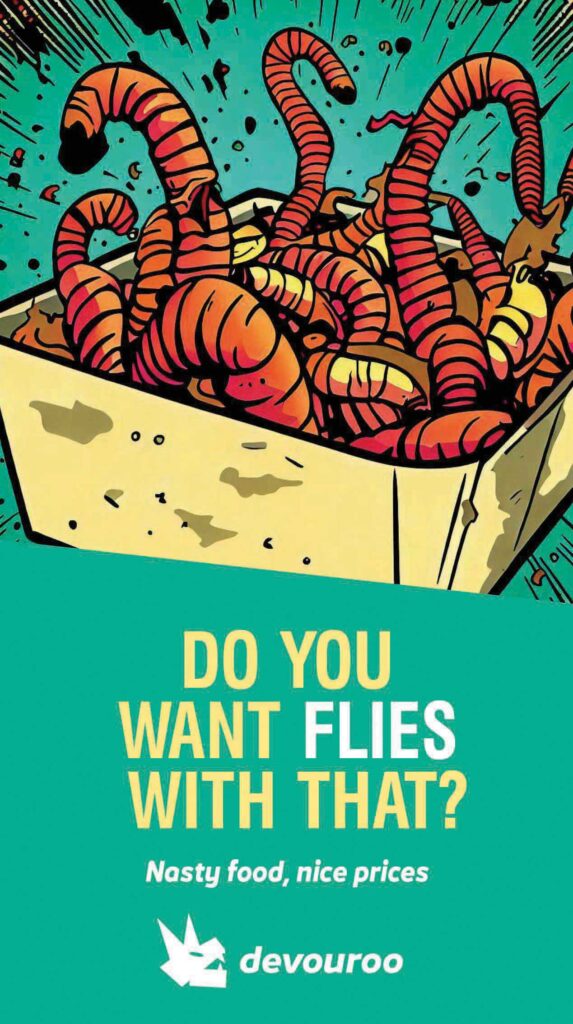
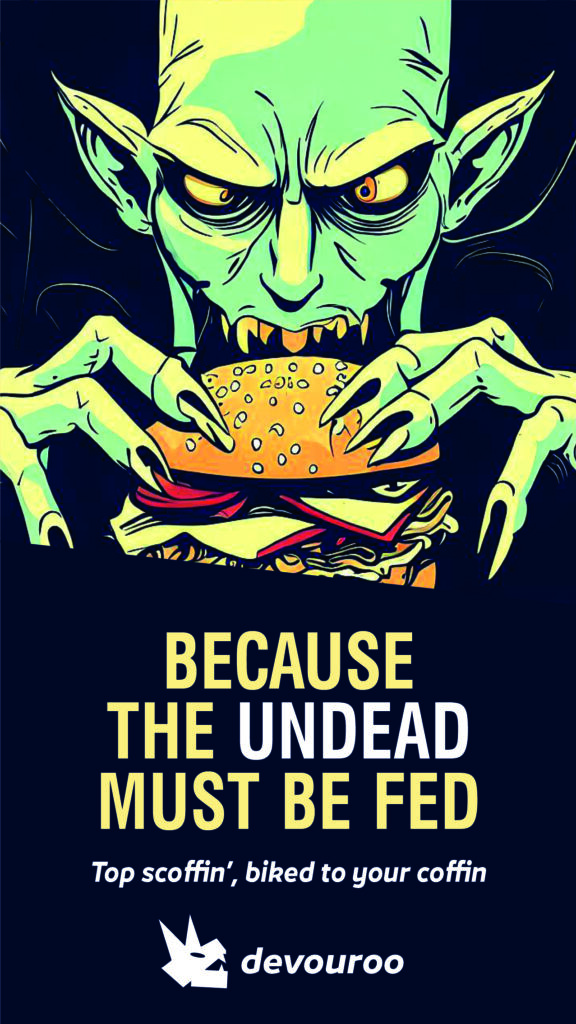
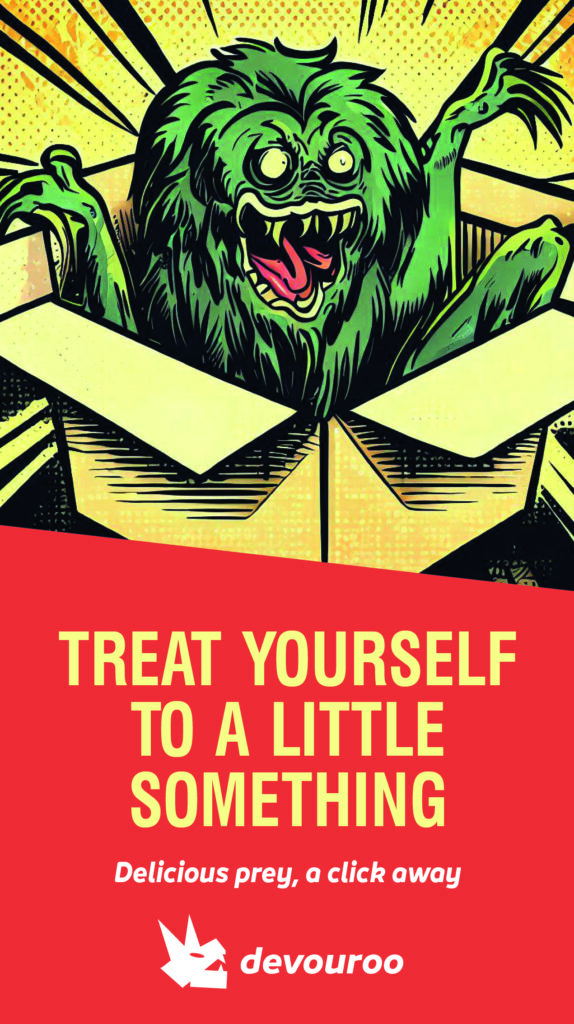
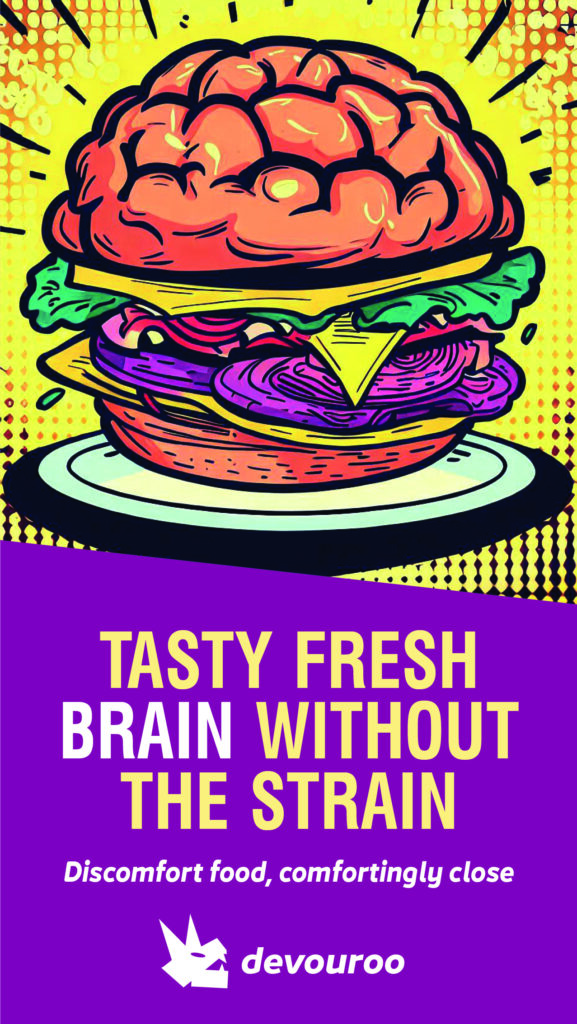
>
Well, thank you so much to John for chatting to us about Portals & Black Goo, especially as he was busy packing for a holiday when we rudely interrupted him to get some answers!
You can find the first episode of Portals & Black Goo: Night Shift in the pages of 2000 AD Prog 2340, available right now from everywhere that stocks Tharg’s zarjaz weekly offering, including the 2000 AD web shop. Just look for the stunning cover by SK Moore.
For more from John, Mike Molcher pinned him down for a 200 AD Thrill-Cast a while back that’s essential listening.
>
